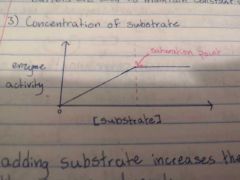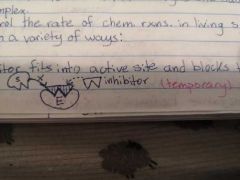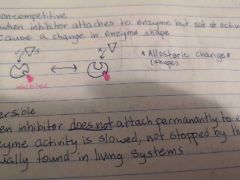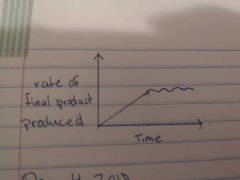![]()
![]()
![]()
Use LEFT and RIGHT arrow keys to navigate between flashcards;
Use UP and DOWN arrow keys to flip the card;
H to show hint;
A reads text to speech;
23 Cards in this Set
- Front
- Back
|
What are enzymes |
Biological catalysts that are made of proteins and lower the activation energy |
|
|
What is metabolism |
The sum of all energy produced by chemical reactions in a living system |
|
|
3 facts of metabolism |
There is a normal range of metabolism in humans Metabolism is controlled by a hormone thyroxin Thyroxin is produced in thyroid gland |
|
|
Hypothyroidism. What is it. Symptoms. Cause |
When too little thyroxin is produced Symptoms: low energy, obesity, goiter, cretinism (lowered IQ, big tongue, slanted forehead, mental issues) May be caused by a lack of Iodine in diet |
|
|
Hyperthyroidism |
When too much thyroxin is produced. Hyperactive, unable to gain weight, opthalmic goitre (behind eyes, eyes bulge) |
|
|
How do enzymes work |

The substrate fits into the active site on the enzyme (lock and key). This forms enzyme/substrate complex which does not last for very long. Then the products are formed and the enzyme gets reused |
|
|
What is an active site |
The spot in an enzyme that the substrate attaches to. It is specific to only one substrate |
|
|
Catabolic vs anabolic reactions |
Catabolic: breakdown substrate (exothermic) (decomposition) Anabolic: build up a product (endothermic) (synthesis) |
|
|
4 factors that affect the ability of enzymes to work |
Temperature pH Concentration of substrate Inhibitors |
|
|
How does temperature affect enzymes |

Increase in temp increases enzyme activity up to a point When too hot, the enzyme is denatured and reaction slows down |
|
|
How does pH affect enzymes |
Each enzyme has a specific pH where it works best (optimal pH) Buffers are used to maintain constant pHs in different body parts |
|
|
How does the concentration of a substrate affect the reaction |

Adding substrate increases the chances of substrate running into the enzyme and reacting At saturation point all enzymes are working as fast as possible, adding more substrate makes no difference |
|
|
How do inhibitors affect enzymes |
They are molecules that interfere with the enzyme and substrate forming a complex Used to control the rate of chemical reactions in living systems |
|
|
Different types of inhibitors |
Competitive Non-competitive Reversible Non-reversible |
|
|
Competitive inhibitor |

When inhibitor fits into active site and blocks the substrate |
|
|
Non-competitive inhibitor |

When inhibitor attaches to enzyme but not at active site. Cause a change in enzyme shape |
|
|
Reversible |
When inhibitor does not attach permanently to enzyme. Enzyme activity is slowed, not stopped by their presence. Usually found in living systems. |
|
|
Non-reversible |
When inhibitor does attach permanently to enzyme. Destroys enzymes function. Poisons (hydrogen, penicillin (not in humans), heavy metals) |
|
|
Metabolic pathways |

Most enzymes do not work independently usually there are part of a metabolic pathway where the product of one reaction becomes the substrate for the next |
|
|
What is negative feedback |
When final products act as inhibitors of enzymes early in the metabolic pathway (self regulation) |
|
|
How do coenzymes/cofactors work |
1) The molecule becomes part of the fit at the active site 2) Molecule interacts with enzyme to alter active site 3) Molecule interacts with substrate to alter shape |
|
|
Cofactors vs coenzymes |
Cofactors: inorganic, small, minerals Coenzymes: organic, small, vitamins |
|
|
Disease/ symptoms associated with deficiency in: vitamin C, vitamin D, Iron, vitamin A |
Vitamin C - scurvy, teeth fall out Vitamin D - rickets, bendy bones Iron - Anemia, tiredness... Vitamin A - night blindness |

